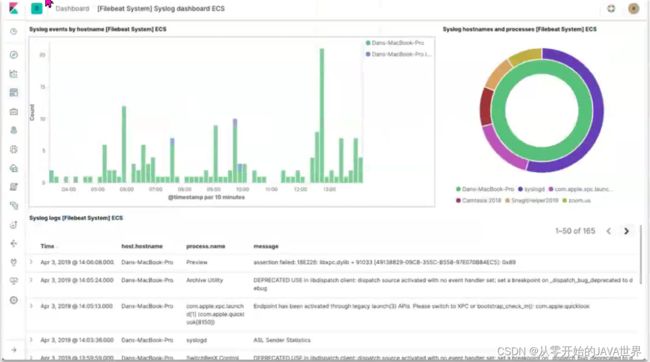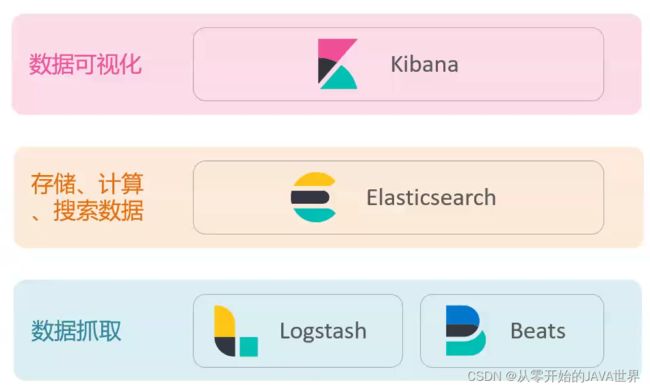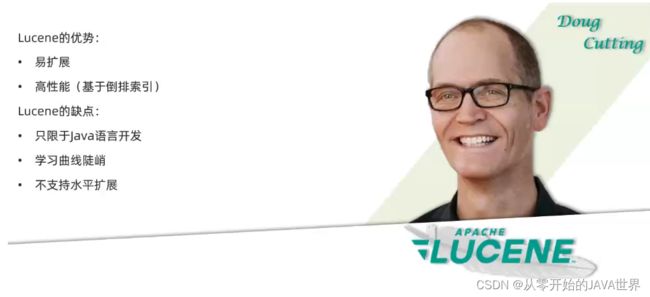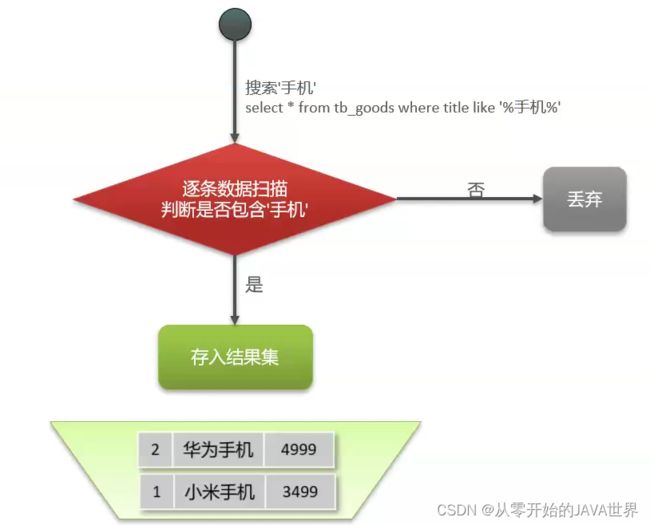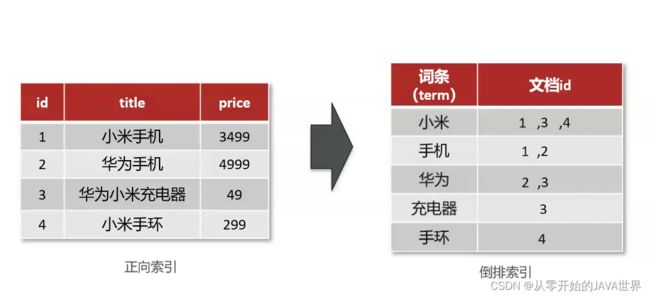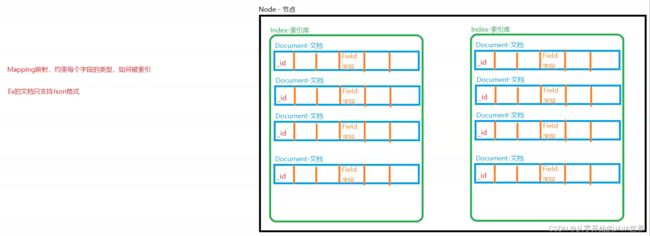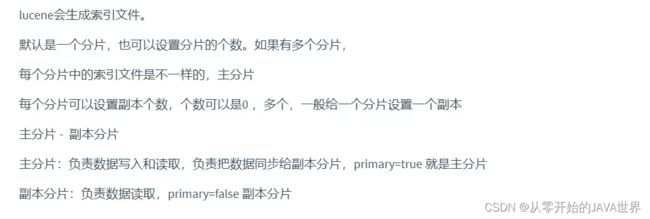ElasticSearch 学习笔记
1.初识elasticsearch
1.1.了解ES
1.1.1.elasticsearch的作用
elasticsearch是一款非常强大的开源搜索引擎,具备非常多强大功能,可以帮助我们从海量数据中快速找到需要的内容
1.1.2.ELK技术栈
elasticsearch结合kibana、Logstash、Beats,也就是elastic stack(ELK)。被广泛应用在日志数据分析、实时监控等领域:
而elasticsearch是elastic stack的核心,负责存储、搜索、分析数据。
1.1.3.elasticsearch和lucene
elasticsearch底层是基于lucene来实现的。
Lucene是一个Java语言的搜索引擎类库,是Apache公司的顶级项目,由DougCutting于1999年研发。官网地址:https://lucene.apache.org/ 。
elasticsearch的发展历史:
- 2004年Shay Banon基于Lucene开发了Compass
- 2010年Shay Banon 重写了Compass,取名为Elasticsearch。
1.1.4.为什么不是其他搜索技术?
目前比较知名的搜索引擎技术排名:
虽然在早期,Apache Solr是最主要的搜索引擎技术,但随着发展elasticsearch已经渐渐超越了Solr,独占鳌头:
1.1.5.总结
什么是elasticsearch?
- 一个开源的分布式搜索引擎,可以用来实现搜索、日志统计、分析、系统监控等功能
什么是elastic stack(ELK)?
- 是以elasticsearch为核心的技术栈,包括beats、Logstash、kibana、elasticsearch
什么是Lucene?
- 是Apache的开源搜索引擎类库,提供了搜索引擎的核心API
1.2.倒排索引
倒排索引的概念是基于MySQL这样的正向索引而言的。
1.2.1.正向索引
那么什么是正向索引呢?例如给下表(tb_goods)中的id创建索引:
但如果是基于title做模糊查询,只能是逐行扫描数据,流程如下:
1)用户搜索数据,条件是title符合"%手机%"
2)逐行获取数据,比如id为1的数据
3)判断数据中的title是否符合用户搜索条件
4)如果符合则放入结果集,不符合则丢弃。回到步骤1
逐行扫描,也就是全表扫描,随着数据量增加,其查询效率也会越来越低。当数据量达到数百万时,就是一场灾难。
1.2.2.倒排索引
倒排索引中有两个非常重要的概念:
- 文档(
Document):用来搜索的数据,其中的每一条数据就是一个文档。例如一个网页、一个商品信息 - 词条(
Term):对文档数据或用户搜索数据,利用某种算法分词,得到的具备含义的词语就是词条。例如:我是中国人,就可以分为:我、是、中国人、中国、国人这样的几个词条
创建倒排索引是对正向索引的一种特殊处理,流程如下:
- 将每一个文档的数据利用算法分词,得到一个个词条
- 创建表,每行数据包括词条、词条所在文档id、位置等信息
- 因为词条唯一性,可以给词条创建索引,例如hash表结构索引
如图:
倒排索引的搜索流程如下(以搜索"华为手机"为例):
1)用户输入条件"华为手机"进行搜索。
2)对用户输入内容分词,得到词条:华为、手机。
3)拿着词条在倒排索引中查找,可以得到包含词条的文档id:1、2、3。
4)拿着文档id到正向索引中查找具体文档。
如图:
虽然要先查询词条,再查询文档id,但是无论是词条、还是文档id都建立了索引,查询速度非常快!无需全表扫描。
1.2.3.正向和倒排
那么为什么一个叫做正向索引,一个叫做倒排索引呢?
- 正向索引是最传统的,根据id索引的方式。但根据词条查询时,必须先逐条获取每个文档,然后判断文档中是否包含所需要的词条,是根据文档找词条的过程。
- 而倒排索引则相反,先用算法得到用户搜索的词条,根据词条匹配,得到文档的id,然后再根据文档id获取文档。是根据词条找文档的过程。
那么两者方式的优缺点是什么呢?
正向索引:
- 优点:
- 可以给多个字段创建索引
- 根据索引字段搜索、排序速度非常快
- 缺点:
- 根据非索引字段,或者索引字段中的部分词条查找时,只能全表扫描。
倒排索引:
- 优点:
- 根据词条搜索、模糊搜索时,速度非常快
- 缺点:
- 只能给词条创建索引,而不是字段
- 无法根据字段做排序
1.3.es的一些概念
elasticsearch中有很多独有的概念,与mysql中略有差别,但也有相似之处。
1.3.1.文档和字段
elasticsearch是面向**文档(Document)**存储的,可以是数据库中的一条商品数据,一个订单信息。文档数据会被序列化为json格式后存储在elasticsearch中:
而Json文档中往往包含很多的字段(Field),类似于数据库中的列。
1.3.2.索引和映射
索引(Index),就是相同类型的文档的集合。
例如:
- 所有用户文档,就可以组织在一起,称为用户的索引;
- 所有商品的文档,可以组织在一起,称为商品的索引;
- 所有订单的文档,可以组织在一起,称为订单的索引;
因此,我们可以把索引当做是数据库中的表。
数据库的表会有约束信息,用来定义表的结构、字段的名称、类型等信息。因此,索引库中就有映射(mapping),是索引中文档的字段约束信息,类似表的结构约束。
1.3.3.mysql与elasticsearch
我们统一的把mysql与elasticsearch的概念做一下对比:
| MySQL | Elasticsearch | 说明 |
|---|---|---|
| Row | Document | 文档(Document),就是一条条的数据,类似数据库中的行(Row),文档都是JSON格式 |
| Table | Index | 索引(index),就是文档的集合,类似数据库的表(table) |
| Column | Field | 字段(Field),就是JSON文档中的字段,类似数据库中的列(Column) |
| Schema | Mapping | Mapping(映射)是索引中文档的约束,例如字段类型约束。类似数据库的表结构(Schema) |
| SQL | DSL | DSL是elasticsearch提供的JSON风格的请求语句,用来操作elasticsearch,实现CRUD |
是不是说,我们学习了elasticsearch就不再需要mysql了呢?
并不是如此,两者各自有自己的擅长支出:
- MySQL:擅长事务类型操作,可以确保数据的安全和一致性
- Elasticsearch:擅长海量数据的搜索、分析、计算
因此在企业中,往往是两者结合使用:
- 对安全性要求较高的写操作,使用mysql实现
- 对查询性能要求较高的搜索需求,使用elasticsearch实现
- 两者再基于某种方式,实现数据的同步,保证一致性
1.4.安装es、kibana、ik分词器插件
1.4.1 安装
https://editor.csdn.net/md/?articleId=125953385
1.4.2 总结
分词器的作用是什么?
- 创建倒排索引时对文档分词
- 用户搜索时,对输入的内容分词
IK分词器有几种模式?
- ik_smart:智能切分,粗粒度
- ik_max_word:最细切分,细粒度
IK分词器如何拓展词条?如何停用词条?
- 利用config目录的IkAnalyzer.cfg.xml文件添加拓展词典和停用词典
- 在词典中添加拓展词条或者停用词条
1.5 分片
2.索引库操作
索引库就类似数据库表,mapping映射就类似表的结构。
我们要向es中存储数据,必须先创建“库”和“表”。
2.1.mapping映射属性
mapping是对索引库中文档的约束,常见的mapping属性包括:
- type:字段数据类型,常见的简单类型有:
- 字符串:text(可分词的文本)、keyword(精确值,例如:品牌、国家、ip地址)
- 数值:long、integer、short、byte、double、float、
- 布尔:boolean
- 日期:date
- 对象:object
- index:是否创建索引,默认为true
- analyzer:使用哪种分词器
- properties:该字段的子字段
例如下面的json文档:
{
"age": 21,
"weight": 52.1,
"isMarried": false,
"info": "你好世界",
"email": "[email protected]",
"score": [99.1, 99.5, 98.9],
"name": {
"firstName": "云",
"lastName": "赵"
}
}
对应的每个字段映射(mapping):
- age:类型为 integer;参与搜索,因此需要index为true;无需分词器
- weight:类型为float;参与搜索,因此需要index为true;无需分词器
- isMarried:类型为boolean;参与搜索,因此需要index为true;无需分词器
- info:类型为字符串,需要分词,因此是text;参与搜索,因此需要index为true;分词器可以用ik_smart
- email:类型为字符串,但是不需要分词,因此是keyword;不参与搜索,因此需要index为false;无需分词器
- score:虽然是数组,但是我们只看元素的类型,类型为float;参与搜索,因此需要index为true;无需分词器
- name:类型为object,需要定义多个子属性
- name.firstName;类型为字符串,但是不需要分词,因此是keyword;参与搜索,因此需要index为true;无需分词器
- name.lastName;类型为字符串,但是不需要分词,因此是keyword;参与搜索,因此需要index为true;无需分词器
2.2.索引库的CRUD
这里我们统一使用Kibana编写DSL的方式来演示。
2.2.1.创建索引库和映射
基本语法:
- 请求方式:PUT
- 请求路径:/索引库名,可以自定义
- 请求参数:mapping映射
格式:
PUT /索引库名称
{
"mappings": {
"properties": {
"字段名":{
"type": "text",
"analyzer": "ik_smart"
},
"字段名2":{
"type": "keyword",
"index": "false"
},
"字段名3":{
"properties": {
"子字段": {
"type": "keyword"
}
}
},
// ...略
}
}
}
示例:
PUT /xin
{
"mappings": {
"properties": {
"info":{
"type": "text",
"analyzer": "ik_smart"
},
"email":{
"type": "keyword",
"index": "false"
},
"name":{
"properties": {
"firstName": {
"type": "keyword"
},
"lastName":{
"type": "keyword"
}
}
}
}
}
}
2.2.2.查询索引库
基本语法:
- 请求方式:GET
- 请求路径:/索引库名
- 请求参数:无
格式:
GET /索引库名
代码
GET /heima
2.2.3.修改索引库
倒排索引结构虽然不复杂,但是一旦数据结构改变(比如改变了分词器),就需要重新创建倒排索引,这简直是灾难。因此索引库一旦创建,无法修改mapping。
虽然无法修改mapping中已有的字段,但是却允许添加新的字段到mapping中,因为不会对倒排索引产生影响。
语法说明:
PUT /索引库名/_mapping
{
"properties": {
"新字段名":{
"type": "integer"
}
}
}
代码
PUT /heima/_mapping
{
"properties":{
"age":{
"type": "integer"
}
}
}
2.2.4.删除索引库
语法:
- 请求方式:DELETE
- 请求路径:/索引库名
- 请求参数:无
格式:
DELETE /索引库名
2.2.5.总结
索引库操作有哪些?
- 创建索引库:PUT /索引库名
- 查询索引库:GET /索引库名
- 删除索引库:DELETE /索引库名
- 添加字段:PUT /索引库名/_mapping
3.文档操作
3.1.新增文档
语法:
POST /索引库名/_doc/文档id
{
"字段1": "值1",
"字段2": "值2",
"字段3": {
"子属性1": "值3",
"子属性2": "值4"
},
// ...
}
示例:
POST /heima/_doc/1
{
"info": "黑马程序员Java讲师",
"email": "[email protected]",
"name": {
"firstName": "云",
"lastName": "赵"
}
}
如果不写文档id,kibana会自动生成一个。
3.2.查询文档
根据REST风格,新增是post,查询应该是get,不过查询一般都需要条件,这里我们把文档id带上。
语法:
GET /{索引库名称}/_doc/{id}
通过kibana查看数据:
GET /xin/_doc/1
3.3.删除文档
删除使用DELETE请求,同样,需要根据id进行删除:
语法:
DELETE /{索引库名}/_doc/id值
示例:
# 根据id删除数据
DELETE /heima/_doc/1
3.4.修改文档
修改有两种方式:
- 全量修改:直接覆盖原来的文档
- 增量修改:修改文档中的部分字段
3.4.1.全量修改
全量修改是覆盖原来的文档,其本质是:
- 根据指定的id删除文档
- 新增一个相同id的文档
注意:如果根据id删除时,id不存在,第二步的新增也会执行,也就从修改变成了新增操作了。
语法:
PUT /{索引库名}/_doc/文档id
{
"字段1": "值1",
"字段2": "值2",
// ... 略
}
示例:
PUT /heima/_doc/1
{
"info": "黑马程序员高级Java讲师",
"email": "[email protected]",
"name": {
"firstName": "云",
"lastName": "赵"
}
}
3.4.2.增量修改
增量修改是只修改指定id匹配的文档中的部分字段。
语法:
POST /{索引库名}/_update/文档id
{
"doc": {
"字段名": "新的值",
}
}
示例:
POST /heima/_update/1
{
"doc":{
"email":"[email protected]"
}
}
3.5.总结
文档操作有哪些?
- 创建文档:POST /{索引库名}/_doc/文档id { json文档 }
- 查询文档:GET /{索引库名}/_doc/文档id
- 删除文档:DELETE /{索引库名}/_doc/文档id
- 修改文档:
- 全量修改:PUT /{索引库名}/_doc/文档id { json文档 }
- 增量修改:POST /{索引库名}/_update/文档id { “doc”: {字段}}
4. RestAPI 操作索引库
ES官方提供了各种不同语言的客户端,用来操作ES。这些客户端的本质就是组装DSL语句,通过http请求发送给ES。官方文档地址:https://www.elastic.co/guide/en/elasticsearch/client/index.html
其中的Java Rest Client又包括两种:
- Java Low Level Rest Client
- Java High Level Rest Client
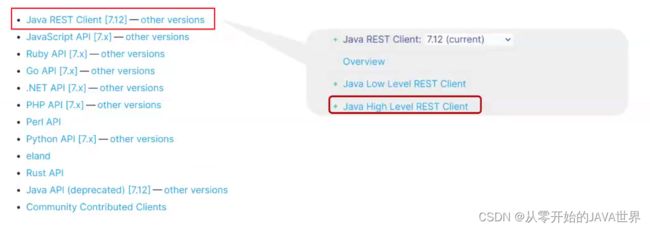
我们学习的是Java HighLevel Rest Client客户端API
4.1 初始化RestHighLevelClient
在elasticsearch提供的API中,与elasticsearch一切交互都封装在一个名为RestHighLevelClient的类中,必须先完成这个对象的初始化,建立与elasticsearch的连接。
分为三步:
1)引入es的RestHighLevelClient依赖:
<dependency>
<groupId>org.elasticsearch.clientgroupId>
<artifactId>elasticsearch-rest-high-level-clientartifactId>
dependency>
2)因为SpringBoot默认的ES版本是7.6.2,所以我们需要覆盖默认的ES版本:
<properties>
<java.version>1.8java.version>
<elasticsearch.version>7.12.1elasticsearch.version>
properties>
3)初始化RestHighLevelClient
初始化的代码如下:
RestHighLevelClient restHighLevelclient = new RestHighLevelClient(RestClient.builder(
HttpHost.create("http://127.0.0.1:9200")
));
4)测试类
@SpringBootTest //测试类
class HotelIndicesTest{
private RestHighLevelClient restHighLevelClient;
@BeforeEach
public void before() {
//配置连接Es服务器
restHighLevelClient = new RestHighLevelClient(RestClient.builder(HttpHost.create("http://127.0.0.1:9200")));
}
@AfterEach
public void after() throws IOException {
//关闭资源
restHighLevelClient.close();
}
}
4.1.创建索引库
//创建索引库和mapping
@Test
void testCreateIndices() throws IOException {
//创建索引库的请求对象
CreateIndexRequest createIndexRequest = new CreateIndexRequest("hotel");
//设置索引库的设置和映射的DSL语句,因为json字符串很长,这里是定义了静态字符串常量MAPPING_TEMPLATE,让代码看起来更加优雅。
createIndexRequest.source(HotelConstants.MAPPING_TEMPLATE, XContentType.JSON);
//发送请求给ES服务端,restHighLevelClient.indices()方法的返回值是IndicesClient类型,封装了所有与索引库操作有关的方法。
restHighLevelClient.indices().create(createIndexRequest, RequestOptions.DEFAULT);
}
4.2.删除索引库
//删除索引库
@Test
public void testDeleteIndices() throws IOException {
//创建删除索引库的Request请求对象
DeleteIndexRequest deleteIndexRequest = new DeleteIndexRequest("hotel");
//发送删除请求
restHighLevelClient.indices().delete(deleteIndexRequest, RequestOptions.DEFAULT);
}
4.3.判断索引库是否存在
//查询索引库是否存在
@Test
public void testExistIndices() throws IOException {
//根据索引库名字获取索引库
GetIndexRequest getIndexRequest = new GetIndexRequest("hotel");
//发送请求
boolean exists = restHighLevelClient.indices().exists(getIndexRequest, RequestOptions.DEFAULT);
System.out.println("hotel索引库,存在吗? -- " + exists);
}
4.4.总结
JavaRestClient操作elasticsearch的流程基本类似。核心是client.indices()方法来获取索引库的操作对象。
索引库操作的基本步骤:
- 初始化RestHighLevelClient
- 创建XxxIndexRequest。XXX是Create、Get、Delete
- 准备DSL( Create时需要,其它是无参)
- 发送请求。调用RestHighLevelClient#indices().xxx()方法,xxx是create、exists、delete
5.Rest API 操作文档
5.1 初始化RestHighLevelClient
@SpringBootTest
class HotelDocumentTest {
private RestHighLevelClient restHighLevelClient;
@Autowired
private HotelService hotelService;
@BeforeEach
public void before() {
//配置连接Es服务器
restHighLevelClient = new RestHighLevelClient(RestClient.builder(HttpHost.create("http://127.0.0.1:9200")));
}
@AfterEach
public void after() throws IOException {
//关闭资源
restHighLevelClient.close();
}
}
5.1.新增文档
我们要将数据库的酒店数据查询出来,写入elasticsearch中。
//新增文档
@Test
public void testAddDocument() throws IOException {
//从数据库查询数据
Hotel hotel = hotelService.getById("36934");
//数据库的数据和ES中的不完全一样,因此属性拷贝
HotelDoc hotelDoc = new HotelDoc(hotel);
//序列化json格式
String str = JSON.toJSONString(hotelDoc);
//创建索引请求
IndexRequest indexRequest = new IndexRequest("hotel").id(hotelDoc.getId().toString());
//设置json格式的数据
indexRequest.source(str, XContentType.JSON);
//发送请求
restHighLevelClient.index(indexRequest, RequestOptions.DEFAULT);
}
5.2.查询文档
//查询文档
@Test
public void testGetDocument() throws IOException {
GetRequest request = new GetRequest("hotel").id("36934");
GetResponse response = restHighLevelClient.get(request, RequestOptions.DEFAULT);
//获取文档内容 (json格式)
String source = response.getSourceAsString();
//JSON -> Object
HotelDoc hotelDoc = JSON.parseObject(source, HotelDoc.class);
System.out.println(hotelDoc);
}
5.3.删除文档
//删除文档
@Test
void testDeleteDocument() throws IOException {
// 1.准备Request
DeleteRequest request = new DeleteRequest("hotel", "36934");
// 2.发送请求
restHighLevelClient.delete(request, RequestOptions.DEFAULT);
}
5.4.修改文档
//修改文档
@Test
public void testUpdateDocument() throws IOException {
//修改hotel索引库中的,文档id为36934的
UpdateRequest updateRequest = new UpdateRequest("hotel", "36934");
//将price的值修改为444,将score的值修改为40
updateRequest.doc("price", "444", "score", 40); //
restHighLevelClient.update(updateRequest, RequestOptions.DEFAULT);
}
5.5.批量导入文档
@Test
void testBulkRequest() throws IOException {
// 批量查询酒店数据
List<Hotel> hotels = hotelService.list();
// 1.创建Request
BulkRequest request = new BulkRequest();
// 2.准备参数,添加多个新增的Request
for (Hotel hotel : hotels) {
// 2.1.转换为文档类型HotelDoc
HotelDoc hotelDoc = new HotelDoc(hotel);
// 2.2.创建新增文档的Request对象
request.add(new IndexRequest("hotel")
.id(hotelDoc.getId().toString())
.source(JSON.toJSONString(hotelDoc), XContentType.JSON));
}
// 3.发送请求
client.bulk(request, RequestOptions.DEFAULT);
}
5.6.小结
文档操作的基本步骤:
- 初始化RestHighLevelClient
- 创建XxxRequest。XXX是Index、Get、Update、Delete、Bulk
- 准备参数(Index、Update、Bulk时需要)
- 发送请求。调用RestHighLevelClient#.xxx()方法,xxx是index、get、update、delete、bulk
- 解析结果(Get时需要)

